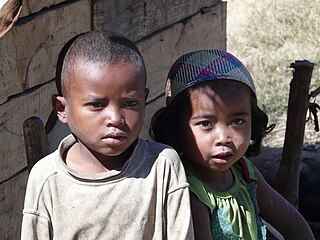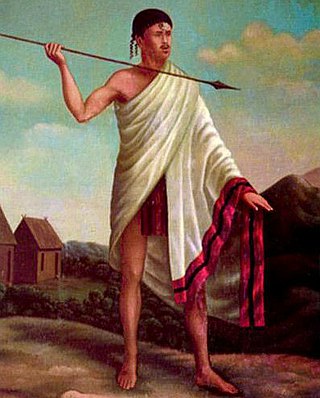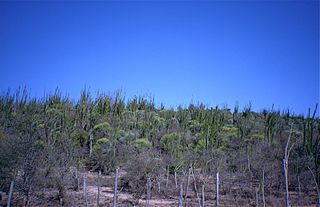Society
The ancestors of today's Antanosy migrated from the north about 150–200 years ago. According to MAEP (2003), they are divided into three groups in the region:
- The Antavaratra Region of Manantenina (an alliance between Antanosy & Antaisaka)
- Those occupying the Antambolo Valley in the region of Ranomafana and Enaniliha
- The Antatsimo who live in the southwest region of Anosy, from Ranopiso to the Mandrare river
While one source indicates there are five sub-ethnic groups of the Antanosy people (the Tesák, Ivondro, Tevatomalama, and Terara Temanalo) Rakotoarisoa indicates from the north of Anosy they are known as the Tavaratra (Manantenina region, though some indicate the people in Manantenina are the Temanantenina, with the Tavaratra located between the Temanantenina and the Tambato), the Tambolo (Ranomafana region), the Tambato (Mahatalaky and Manafiafy region), the Tanosy (Fanjahira region) and the Tatsimo (Ranopiso region). However, this is still a simplification of a more complex reality, as in central Anosy alone there are 30 village clans.
Another way to describe the Antanosy is to focus on the Zafiraminia people who arrived in Anosy in the 16th Century, conquering those already living there, and whose former dynasty is bounded by cemeteries named Enosiavaratse (Manarivo), Enosy atsimo (Andromira) and Samby Anosy (Ifarantsa). For a picture of Antanosy warriors see [6] )

The history of Madagascar is distinguished clearly by the early isolation of the landmass from the ancient supercontinent of Pangaea, containing amongst others the African continent and the Indian subcontinent, and by the island's late colonization by human settlers from the Sunda islands and from East Africa. These two factors facilitated the evolution and survival of thousands of endemic plant and animal species, some of which have gone extinct or are currently threatened with extinction. Trade in the Indian Ocean at the time of first colonization of Madagascar was dominated by Indonesian ships, probably of Borobudur ship and K'un-lun po types.

Radama I "the Great" (1793–1828) was the first Malagasy sovereign to be recognized as King of Madagascar (1810–1828) by a European state. He came to power at the age of 18 following the death of his father, King Andrianampoinimerina. Under Radama's rule and at his invitation, the first Europeans entered his central highland Kingdom of Imerina and its capital at Antananarivo. Radama encouraged these London Missionary Society envoys to establish schools to teach tradecraft and literacy to nobles and potential military and civil service recruits; they also introduced Christianity and taught literacy using the translated Bible. A wide range of political and social reforms were enacted under his rule, including an end to the international slave trade, which had historically been a key source of wealth and armaments for the Merina monarchy. Through aggressive military campaigns he successfully united two-thirds of the island under his rule. Abuse of alcohol weakened his health and he died prematurely at age 35. He was succeeded by his highest-ranking wife, Ranavalona I.

The Merina people are the largest ethnic group in Madagascar. They are the "highlander" Malagasy ethnic group of the African island and one of the country's eighteen official ethnic groups. Their origins are mixed, predominantly with Austronesians arriving before the 5th century AD, then many centuries later with mostly Bantu Africans, but also some other ethnic groups. They speak the Merina dialect of the official Malagasy language of Madagascar.

The Betsileo are a highland ethnic group of Madagascar, the third largest in terms of population. They chose their name, meaning "The Many Invincible Ones", after a failed invasion by King Ramitraho of the Menabe kingdom in the early 19th century.

Fort-Dauphin is a city on the southeast coast of Madagascar. It is the capital of the Anosy Region and of the Taolagnaro District. It has been a port of local importance since the early 1500s. A new port, the Ehoala Port was built in 2006–2009. Fort-Dauphin was the first French settlement in Madagascar.

Andrianampoinimerina (1745–1810) ruled the Kingdom of Imerina on Madagascar from 1787 until his death. His reign was marked by the reunification of Imerina following 77 years of civil war, and the subsequent expansion of his kingdom into neighboring territories, thereby initiating the unification of Madagascar under Merina rule. Andrianampoinimerina is a cultural hero and holds near mythic status among the Merina people, and is considered one of the greatest military and political leaders in the history of Madagascar.

The Sakalava are an ethnic group of Madagascar. They are found on the western and northwest region of the island, in a band along the coast. The Sakalava are one of the smallest ethnic groups, constituting about 6.2 percent of the total population, that is about 2,079,000 in 2018. Their name means "people of the long valleys." They occupy the western edge of the island from Toliara in the south to the Sambirano River in the north.
Articles related to Madagascar include:

Androy is the most southerly region of Madagascar. It covers an area of 19,540 km2, and had a population of 903,376 inhabitants in 2018. The administrative capital is Ambovombe-Androy.

Anosy is one of the 22 regions of Madagascar. It is located in the southeast of the country, on the eastern side of what was once the Toliara Province. The name Anosy means "island(s)" in Malagasy.

Andriana was both the noble class and a title of nobility in Madagascar. Historically, many Malagasy ethnic groups lived in highly stratified caste-based social orders in which the andriana were the highest strata. They were above the Hova and Andevo (slaves). The Andriana and the Hova were a part of Fotsy, while the Andevo were Mainty in local terminology.

The Merina Kingdom, or Kingdom of Madagascar, officially the Kingdom of Imerina, was a pre-colonial state off the coast of Southeast Africa that, by the 18th century, dominated most of what is now Madagascar. It spread outward from Imerina, the Central Highlands region primarily inhabited by the Merina ethnic group with a spiritual capital at Ambohimanga and a political capital 24 km (15 mi) west at Antananarivo, currently the seat of government for the modern state of Madagascar. The Merina kings and queens who ruled over greater Madagascar in the 19th century were the descendants of a long line of hereditary Merina royalty originating with Andriamanelo, who is traditionally credited with founding Imerina in 1540.

The Betsimisaraka are the second largest ethnic group in Madagascar after the Merina and make up approximately fifteen percent of the Malagasy people. They occupy a large stretch of the eastern coastal region of Madagascar, from Mananjary in the south to Antalaha in the north. The Betsimisaraka have a long history of extensive interaction with European seafarers, pirates and bourgeois traders, which produced a significant subset with mixed European-Malagasy origins, termed the zana-malata. European influence is evident in the local valse (waltz) and basesa musical genres, which are typically performed on the accordion. Tromba ceremonies feature strongly in Betsimisaraka culture.

The Antemoro are an ethnic group of Madagascar living on the southeastern coast, mostly between Manakara and Farafangana. Numbering around 500,000, this ethnic group mostly traces its origins back to East African Bantu and Indonesian Austronesian speakers like most other Malagasy. A minority of them belonging to the Anteony (aristocrats), Antalaotra or Anakara clans claim being descendants of settlers who arrived from Arabia, Persia but more likely Somalia from Dir part of the human Haplogroup T-M184; the religion was soon abandoned in favor of traditional beliefs and practices associated with respect for the ancestors, although remnants of Islam remain in fady such as the prohibition against consuming pork. In the 16th century an Antemoro kingdom was established, supplanting the power of the earlier Zafiraminia, who descended from seafarers of Sumatran origin.

The Bara people are a Malagasy ethnic group living in the southern part of the central plateaus of Madagascar, in the Toliara Province, concentrated around their historic capital at Ihosy. The Bara are the largest of the island's zebu-herding peoples and have historically lived a semi-nomadic lifestyle, although an increasing proportion are practicing agriculture. Bara society is highly patriarchal and endogamy and polygamy are practiced among some Bara tribes. Young men practice cattle rustling to prove their manhood before marriage, and the kilalaky musical and dance tradition associated with cattle rustlers has gained popularity across the island.
The Antaifasy are an ethnic group of Madagascar inhabiting the southeast coastal region around Farafangana. Historically a fishing and farming people, many Antaifasy were heavily conscripted into forced labor (fanampoana) and brought to Antananarivo as slaves under the 19th century authority of the Kingdom of Imerina. Antaifasy society was historically divided into three groups, each ruled by a king and strongly concentrated around the constraints of traditional moral codes. Approximately 150,000 Antaifasy inhabit Madagascar as of 2013.

The Bezanozano are believed to be one of the earliest Malagasy ethnic groups to establish themselves in Madagascar, where they inhabit an inland area between the Betsimisaraka lowlands and the Merina highlands. They are associated with the vazimba, the earliest inhabitants of Madagascar, and the many vazimba tombs throughout Bezanozano territory are sites of pilgrimage, ritual and sacrifice, although the Bezanozano believe the descendants among them of these most ancient of ancestors cannot be identified or known. Their name means "those of many small plaits" in reference to their traditional hairstyle, and like the Merina they practice the famadihana reburial ceremony. There were around 100,000 Bezanozano living in Madagascar in 2013.

The Makoa are an ethnic group in Madagascar descended from enslaved people from mainland Africa that were traded through the major slave trading ports of northern Mozambique in an area mainly populated by the Makua people. They are among the last African diaspora communities in the world to issue from the slave trade. They are sometimes classified as a subgroup of the fishing peoples known as the Vezo, although the Makoa maintain a distinct identity, one reinforced by their larger physical stature and historic employment as police officers by the French colonial administration.

The Sihanaka are a Malagasy ethnic group concentrated around Lake Alaotra and the town of Ambatondrazaka in central northeastern Madagascar. Their name means the "people of the swamps" in reference to the marshlands around Lake Alaotra that they inhabit. While rice has long been the principal crop of the region, by the 17th century, the Sihanaka had also become wealthy traders in slaves and other goods, capitalizing on their position on the main trade route between the capital of the neighboring Kingdom of Imerina at Antananarivo and the eastern port of Toamasina. At the turn of the 19th century they came under the control of the Boina Kingdom before submitting to Imerina, which went on to rule over the majority of Madagascar. Today the Sihanaka practice intensive agriculture and rice yields are higher in this region than elsewhere, placing strain on the many unique plant and animal species that depend on the Lake Alaotra ecosystem for survival.

The district of Taolagnaro is a district of Anosy in Madagascar.


















